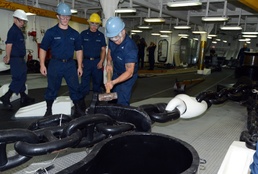
By Mass Communication Specialist Seaman Chelsea Mandello
Amphibious Squadron 11 Public Affairs
SASEBO, Japan - They paint the hulls of a ship, lower an anchor that can weigh 40,000 pounds and throw large nylon ropes called lines to tie a ship down in port. Who are Boatswain’s Mates, what do they do for a ship and why is the rating important?
“We do everything from dropping the anchor to refueling the ship,” said Boatswain’s Mate 1st Class Adam Neville. “We can refuel other ships from our flight deck, we recover man over boards, we bring in Landing Craft Units [LCU]s.”
Officially established in 1797 the Boatswain’s Mate rating is the oldest rate of the United States Navy. Boatswain’s mates train, direct and supervise a ship’s maintenance in addition to other tasks depending on the ship. For forward-deployed amphibious assault ship USS Bonhomme Richard (LHD 6) the boatswain’s mates handle a majority of tasks from painting the bulkheads, maintaining the ship’s upkeep, dropping the anchor, handling lines, deck equipment and life boats.
“Everything we do is dangerous,” said Boatswain’s Mate 2nd Class Bridney Brown. “I don’t think a lot of people understand how dangerous being a Boatswain’s Mate can be. In everything situational awareness is important.”
Aboard the Bonhomme Richard, boatswain’s mates help marines bring aboard equipment and personnel on various transports such as Landing Craft Air Cushions or Landing Craft Units. They maintain general cleanup and deck maintenance.
“It’s not all about preservation,” said Boatswain’s Mate Chief Jeffrey Brooks. “Everyone see’s what we do in port and it is preservation, but no one ever sees the 2 o’clock in the morning evolution on the well deck or having to be on station an hour before an evolution begins. Our guys are standing five-hour watches on top of those kinds of evolutions.”
Boatswain’s mates are most recognized for piping signals and handling lines while bringing a ship into port. The lines, weighing anywhere from 25-50 pounds, are lowered from the ship to the dock and then tied to metal fittings called bollards along the dock.
“Other sailors see lines and line handlers,” said Boatswain’s Mate 2nd Class Bridney Brown. “But these are things that can take a leg, an arm or a life.”
“The amount of work we put in is overlooked,” said Gregory Foster Seaman Apprentice. “To really be a Boatswain’s Mate you need to be proud of your work. I love working with this rate. This is exactly what I want to do.”
Foster is an undesignated Seaman Apprentice trying to become a rated Boatswain’s Mate. Like many other undesignated sailors, he was sent to work with the ship’s deck department to learn about the different rates available aboard a United States Navy ship.
“The junior sailors are the backbone of the Navy,” said Boatswain’s Mate 1st Class Adam Neville. “I really think that what is overlooked is what the junior sailors do. They do everything from painting to casting off and getting the ship ready, recovering the man overboard and getting the fuel.”
The Navy takes pride in its sailors ability to be hard working and always prepared. The foundation of the Fleet is its sailors. Boatswain’s Mates lead the example of being ever ready and dedicated to the Navy’s mission.
“I love being a Boatswain’s mate,” said Boatswain Lt. j.g. David Roach. “Anyone can be any rate, but only god can make a Boatswain’s Mate.”